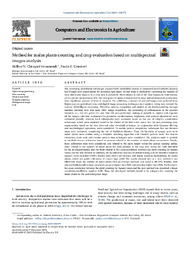Method for maize plants counting and crop evaluation based on multispectral images analysis.
Method for maize plants counting and crop evaluation based on multispectral images analysis.
Author(s): VERAMENDI, W. N. C.; CRUVINEL, P. E.
Summary: The processing of multispectral images acquired with embedded cameras in unmanned aerial vehicles (drones) has brought new opportunities for precision agriculture. In this study a method for evaluating the number of corn plants (Zea mays L) in a crop area is presented. Plant density is one of the most important yield factors, yet its precise measurement after the emergence of plants is impractical in large and medium-scale production, since significant amount of labor is required. For validation, a dataset of spectral images was gathered from flights over an agricultural area, and digital image processing techniques were applied, taking into account the concept of intelligent processing. Therefore, pattern recognition and models to aid decision-making through machine learning were also used. After image acquisition, the processing of orthomosaics in the spectral channels, i.e., red (R), green (G), and blue (B), was performed, making it possible to register and organize all the images. Likewise, techniques for geometric transformation, brightness, and contrast adjustments were evaluated globally, whereas local adjustments were evaluated based on the use of adaptive equalization techniques, which were explored based in the choice of the HSV color space. For the post-processing step, segmentation based on the best observed color threshold technique, in conjunction with Gaussian filtering and morphological operations, were considered. To enable pattern recognition, techniques that use distance maps were evaluated, considering the use of Euclidean distance. Thus, the locations of canopy patterns in maize plants were studied using a template matching algorithm and Chamfer pattern mask. For feature extraction, chain code and circular pattern map techniques were considered. The analyses made it possible to establish vectors of features based on patterns related to the number of maize plants occurrences. Finally, three calibration steps were considered, one related to the plant height versus the canopy opening radius, other related to the number of maize plants for each position in the crop area versus the radii identified by the developed model, and the third related to the cross-correlation between the plant counting by human vision and the new method. In addition, the classification step was established using a set of classifiers based on support vector machine (SVM). Results have shown an accurate and timely counting methodology for maize plants, which can guide cultivation to ensure high yield. The results showed that as a new method it can effectively count the number of maize plants with an average accuracy rate equal to 88.47%. Besides, both selected SVM classifiers have presented accuracy higher than 84% and precision higher than 83%. Furthermore, the cross-correlation between the plant counting by human vision and the new method has presented a linear correlation coefficient equal to 0.98. Thus, the developed method proved to be adequate for counting the maize plants in the post-emergence stage.
Publication year: 2024
Types of publication: Journal article
Unit: Embrapa Instrumentation
Observation
Some of Embrapa's publications are published as ePub files. To read them, use or download one of the following free software options to your computer or mobile device. Android: Google Play Books; IOS: iBooks; Windows and Linux: Calibre.
Access other publications
Access the Agricultural Research Database (BDPA) to consult Embrapa's full library collection and records.
Visit Embrapa Bookstore to purchase books and other publications sold by Embrapa.

